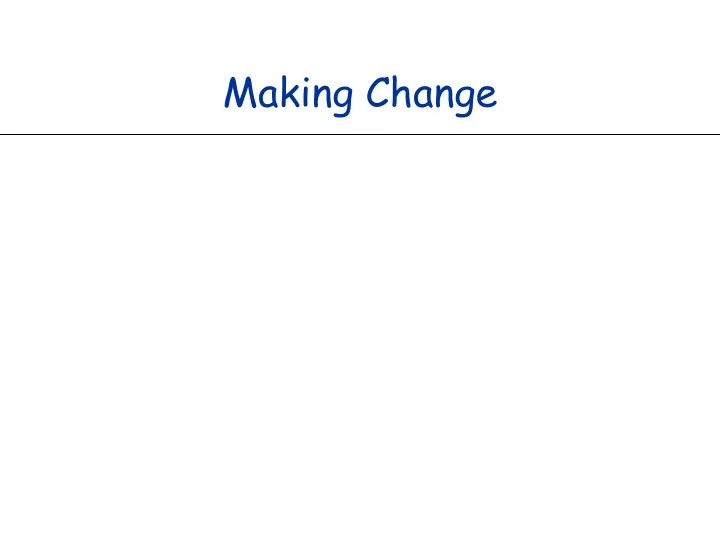

Making Change
Coin Changing Goal. Given currency in integer denominations: {100, 25, 10, 5, 1} devise a method to pay in integer r amount to customer using the fe fewest t number of coins. s. Example: 34¢. Cashier's algorithm. At each iteration, add coin of the largest value that does not take us past the amount to be paid. Example: $2.89 = 289¢. 2
Coin-Changing: Greedy Algorithm Cashier's algorithm. Use the maximal number of the largest denomination x – amount to be changed Sort coins denominations by value: c 1 < c 2 < … < c n . S ¬ f co coin ins select cted while (x > 0) { let k be largest integer such that c k £ x if (k = 0) return "no solution found" x ¬ x - c k S ¬ S È {k} } return S Does this algorithm always work? 3
Coin-Changing: Greedy doesn’t always work Greedy algorithm works for US coins Proof: number theory optimally with coin set Greedy fails changing 30 30 op {2 {25, , 10, , 1} Greedy fails changing 30 30 at at al all with coin set {25, {2 , 10} 4
Different problem: number of ways to pay Given a coin set c = {c 0 , c 1 , ..., c d-1 } and an amount M, how many different ways can M be paid? Recursive solution: is this a take / don’t take type of problem? e.g., for eg 56 cents I can use 0, 1, or 2 quarters One possi ssible (not the only) so solution Ba Base: if d == 0, how many ways? (is there always a way ?) St Step: if d>0 at least how many c d coins can be used and which problem then remains to be solved? ... at most how many c d coins can be used and which problem then remains to be solved? Now turn Recursive into Dynamic Programming 5
Making Change Recursive 29 d=3: Quarters 0 1 29 4 d=2: Dimes 2 1 0 29 19 9 . . . . . . d=1: Nickles 3 2 1 0 19 9 14 4 d=0: Cents
Compare it to Subset Sum Dynamic Programming Go through the state space bottom-up: i=1 to n ■ select coin type i, – first 1 coin type, then 2, ......, all coin types – what does the first column look like? ■ use solutions of smaller sub-problems to efficiently compute solutions of larger ones – in sss / knapsack there are 2 sub-problems – in coins there are how many? S o ... S k 1 2 3 … i-1 i coins considered 7
Recommend
More recommend